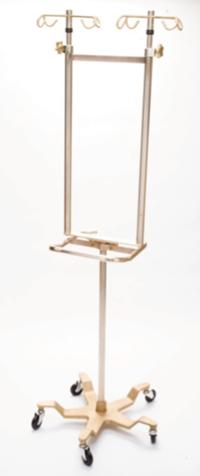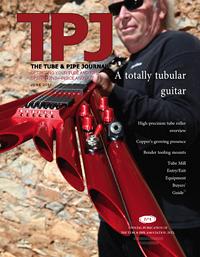- FMA
- The Fabricator
- FABTECH
- Canadian Metalworking
Categories
- Additive Manufacturing
- Aluminum Welding
- Arc Welding
- Assembly and Joining
- Automation and Robotics
- Bending and Forming
- Consumables
- Cutting and Weld Prep
- Electric Vehicles
- En Español
- Finishing
- Hydroforming
- Laser Cutting
- Laser Welding
- Machining
- Manufacturing Software
- Materials Handling
- Metals/Materials
- Oxyfuel Cutting
- Plasma Cutting
- Power Tools
- Punching and Other Holemaking
- Roll Forming
- Safety
- Sawing
- Shearing
- Shop Management
- Testing and Measuring
- Tube and Pipe Fabrication
- Tube and Pipe Production
- Waterjet Cutting
Industry Directory
Webcasts
Podcasts
FAB 40
Advertise
Subscribe
Account Login
Search
Antimicrobial copper displaces stainless steel, germs for medical applications
Alloys have natural germ-killing properties
- June 20, 2011
- Article
- Metals/Materials

Figure 1: Several copper alloys are used increasingly for medical equipment because of their ability to kill germs. An example is an IV pole made from copper nickel and brass. Photo courtesy of Steelcraft Inc.
Take a walk through a hospital and you'll see stainless steel, and lots of it. It's used for bedrails, handrails, and the handles on medical equipment carts, just to name a few. These surfaces that hospital staff and patients contact frequently are called touch surfaces in hospital jargon. Stainless steel is easy to clean and doesn't corrode, so it's not a bad choice for touch surfaces. Nevertheless, it might not be the best choice for touch surfaces. Other metals have been shown to kill microbes, and copper alloys have been making headway in medical settings (see Figure 1).
Louis Pasteur developed the germ theory of disease in the 19th century. It states that infections are caused by microbes invading the human body. This doesn't mean humans are defenseless. The beneficial antimicrobial attributes of copper, brass, and bronze were recognized thousands of years ago. The Hippocratic Collection, a compilation of early medical writings associated with Hippocrates (460 to 380 B.C.), recommends the use of copper for leg ulcers related to varicose veins. Pliny the Elder, A.D. 23 to 79, used copper oxide with honey to treat intestinal worms. Aztecs gargled with a mixture containing copper to treat sore throats.
How does copper kill microbes? This is the subject of ongoing research and several theories have been developed. One such theory is based on the fact that every living cell has a tiny amount of electrical current and a transmembrane potential, which is the voltage difference between the inside and the outside of the cell. Evidence shows that when copper contacts a bacterium, the copper causes short-circuiting, which weakens the membrane and creates holes in the cell.
EPA Testing
A 1983 study by P. Kuhn measured bacteria levels on brass and stainless steel doorknobs in a hospital. Results confirmed that the brass doorknob exhibited almost no microbial growth, while the stainless steel doorknob was heavily contaminated. Two decades later, these observations spurred in-depth and scientifically controlled studies using test protocols specified by the U.S. Environmental Protection Agency (EPA) to quantify the antimicrobial property of copper and copper alloys.
Independent laboratory tests demonstrate that in less than two hours, copper-alloy surfaces kill disease-causing bacteria,* including methicillin-resistant Staphylococcus aureus (MRSA) and E. coli O157:H7 (see Figure 2). Specifically, bacterial colonies placed on copper (C11000) surfaces were observed to be reduced by more than 99.9 percent within two hours. Similar testing demonstrated that several copper alloys such as brass, bronze, and copper nickel exhibited reduction of bacteria greater than 99.9 percent within two hours of contact. Almost no reduction was observed in colonies placed on stainless steel and plastic surfaces after six hours, and a complete kill was not observed even after 24 days. An important point is that the tests were done at temperatures typical of hospital rooms, about 68 degrees F.
The EPA reviewed these studies and concluded that uncoated copper alloys kill more than 99.9 percent of disease-causing bacteria within two hours of contact and that these solid materials can be used for surfaces that are frequently touched, offering an additional line of defense against bacteria.
The result is that the EPA has registered more than 350 copper alloys with a minimum copper content of 60 percent as antimicrobial.
Tarnish
The issue of tarnish, or the natural oxidation of copper and copper alloys, is frequently mentioned, as it is well-known that these metals tarnish in most environments. The EPA evaluated the effects of tarnish on copper surfaces and concluded that normal tarnishing does not impair antimicrobial effectiveness. Furthermore, many copper alloys are available that maintain a consistent appearance in indoor environments.
Clinical Trials
Ongoing and completed clinical trials at major hospitals in the U.S., Chile, Germany, United Kingdom, and Japan are confirming these findings. The critical touch surfaces in typical patient care settings have been cataloged, and prototypes of hospital equipment have been manufactured from antimicrobial copper alloys and put into use. These surfaces include IV poles, bedrails, overbed tables,door hardware, room furniture, bathroom furniture, and other items in close proximity to the patient. Copperized equipment installed in the hospital rooms are swabbed for microbial contamination and compared with noncopper equivalents in control rooms.
Ultimately, these trials will investigate the impact of copper surfaces on surface contamination and infection rates. Data suggests that the copper surfaces exhibit a significant reduction in microbial contamination.

Figure 2. When placed on an antimicrobial surface, E. coli O157:H7 dies off slowly at first, then succumbs rapidly.
Stipulations
To maintain the inherent antimicrobial property of copper, products must not be painted, lacquered, varnished, waxed, or coated in any way. As with liquid and gaseous disinfectants, antimicrobial copper alloys have been shown to reduce microbial contamination but do not necessarily prevent cross-contamination.
Copper can't do the job by itself. Products made from these materials should continue to be cleaned according to regular hygienic practices. It also should be noted that these alloys are not registered for use in food-contact or drinking water applications.
Manufacturers, fabricators, and suppliers that have EPA registration may use Antimicrobial Copper™ and the Cu+ mark to indicate that their products are made from EPA-registered antimicrobial alloys. Interested manufacturers should contact the Copper Development Association.
James Michel is manager of technical services, Wilton Moran is a project engineer, Harold Michels is senior vice president of technology and technical services, and Adam Estelle is a project engineer for the Copper Development Association Inc., 260 Madison Ave., New York, NY 10016, 212-251-7200, questions@cda.copper.org, www.copper.org.
*Laboratory testing shows that, when cleaned regularly, Antimicrobial Copper kills more than 99.9 percent of the following bacteria within two hours of exposure: Staphylococcus aureus, methicillin-resistant Staphylococcus aureus (MRSA), vancomycin-resistant Enterococcus faecalis (VRE), Enterobacter aerogenes, Pseudomonas aeruginosa, and E. coli O157: H7. All references to bacteria killed on copper-alloy surfaces in this article pertain to these six specific bacteria. References are available upon request.
About the Publication
subscribe now

The Tube and Pipe Journal became the first magazine dedicated to serving the metal tube and pipe industry in 1990. Today, it remains the only North American publication devoted to this industry, and it has become the most trusted source of information for tube and pipe professionals.
start your free subscription- Stay connected from anywhere

Easily access valuable industry resources now with full access to the digital edition of The Fabricator.

Easily access valuable industry resources now with full access to the digital edition of The Welder.

Easily access valuable industry resources now with full access to the digital edition of The Tube and Pipe Journal.
- Podcasting
- Podcast:
- The Fabricator Podcast
- Published:
- 04/16/2024
- Running Time:
- 63:29
In this episode of The Fabricator Podcast, Caleb Chamberlain, co-founder and CEO of OSH Cut, discusses his company’s...
- Trending Articles
Team Industries names director of advanced technology and manufacturing

Orbital tube welding webinar to be held April 23

Zekelman Industries to invest $120 million in Arkansas expansion

Push-feeding saw station cuts nonferrous metals

3D laser tube cutting system available in 3, 4, or 5 kW

- Industry Events
16th Annual Safety Conference
- April 30 - May 1, 2024
- Elgin,
Pipe and Tube Conference
- May 21 - 22, 2024
- Omaha, NE
World-Class Roll Forming Workshop
- June 5 - 6, 2024
- Louisville, KY
Advanced Laser Application Workshop
- June 25 - 27, 2024
- Novi, MI


























